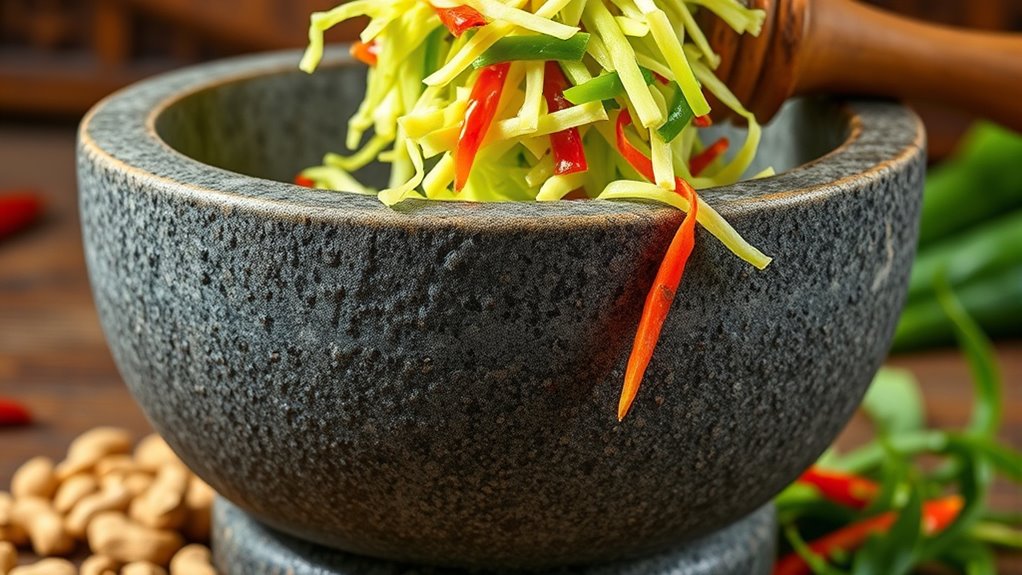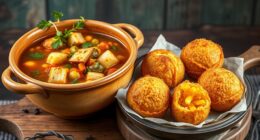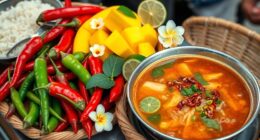Mastering the mortar and pestle is key to authentic Thai Som Tam. It lets you control ingredient textures, reveal deep flavors, and mimic traditional techniques. Proper pounding involves gentle, rhythmic strikes to soften and blend ingredients without over-mashing, ensuring the dish retains crunch and freshness. Balancing flavors requires adding ingredients gradually and tasting as you go. Avoid common mistakes like over-pounding or rushing. If you keep honing your technique, you’ll unlock the true essence of this iconic dish.
Key Takeaways
- Proper mortar technique involves rhythmic, controlled pounding to release flavors without over-mashing ingredients.
- Sequential ingredient addition and gentle pressing ensure balanced flavor and optimal texture.
- Using the pestle’s weight and steady rhythm helps control force, preventing bitterness and sogginess.
- Rotating ingredients within the mortar promotes even flavor distribution and consistent blending.
- Practicing mindfulness and auditory cues enhances technique, ensuring authentic, well-balanced Som Tam.
The Role of the Mortar and Pestle in Authentic Som Tam
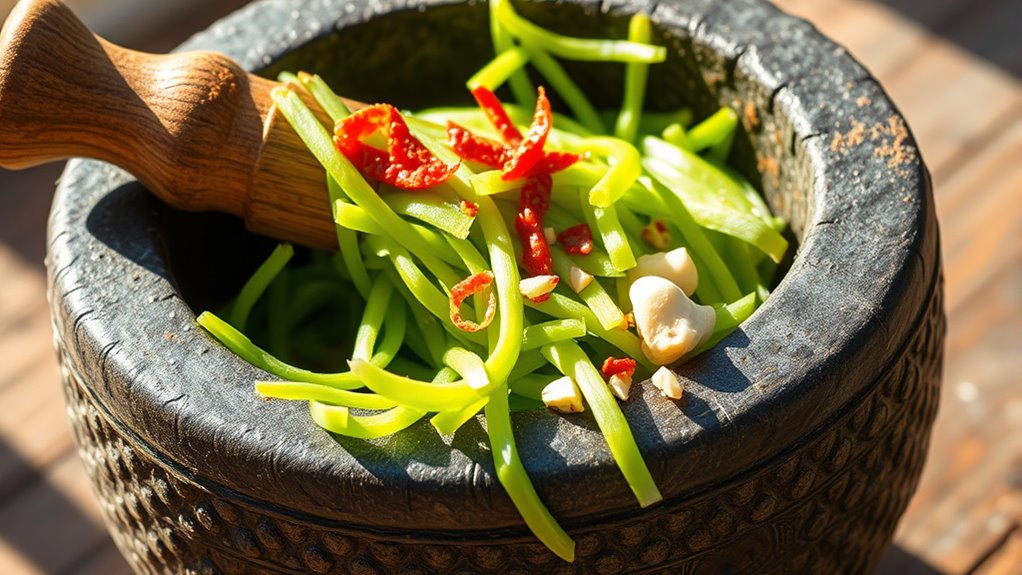
The mortar and pestle are essential tools in making authentic Som Tam because they allow you to crush and combine ingredients with control and precision. Using this traditional tool helps you release the flavors and aromas of garlic, chili, and lime zest more effectively than chopping or blending. As you grind, you can adjust the pressure to achieve the desired consistency and flavor intensity. This method promotes a more authentic taste, capturing the essence of the ingredients. It also allows you to incorporate small amounts of ingredients gradually, ensuring a balanced blend. With the mortar and pestle, you’re actively engaged in the process, which is key to creating the complex, layered flavors that define true Som Tam. Incorporating traditional cooking techniques like using a mortar and pestle enhances the authenticity and depth of flavor in your dish. Additionally, mastering proper grinding methods ensures you maximize the release of essential oils and aromas from each ingredient. Engaging with these methods also fosters a deeper appreciation for culinary heritage, connecting you to traditional Thai food practices. Moreover, understanding flavor extraction can help in developing skills applicable across various traditional dishes.
Achieving the Perfect Texture Through Proper Poundings
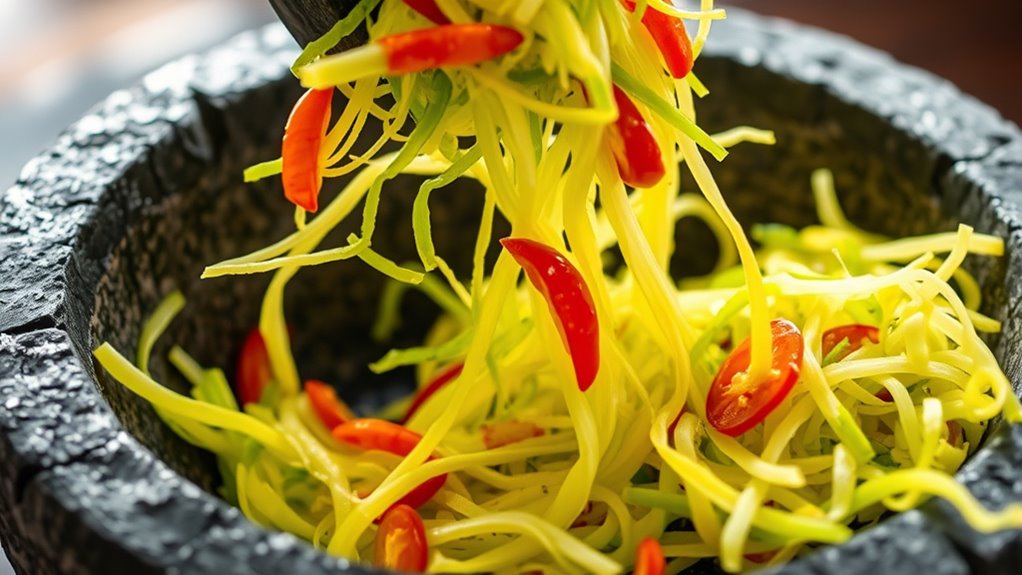
Mastering the right pounding technique is key to achieving the ideal texture in your Som Tam. You want a balance between crushing and preserving the ingredients’ integrity. Use firm, rhythmic strikes to break down the chili, garlic, and sugar, releasing their flavors without turning everything into mush. When adding the green beans and shredded papaya, gently pound to soften but retain some crunch. Avoid over-pounding, which can lead to a soggy or overly mashed salad. Instead, focus on consistent, controlled motions that blend the flavors while maintaining the desired texture. The goal is to create a vibrant mix of crispy, tender, and juicy components, making each bite lively and satisfying. Proper pounding ensures your Som Tam achieves that perfect harmony of textures. Additionally, maintaining the right gear shifting technique on your tools can help control the pounding pressure and motion for optimal results. Employing proper pounding rhythm techniques can further enhance the consistency and quality of your salad. Incorporating mindful technique adjustment can also prevent over-processing and preserve the freshness of the ingredients. Being aware of culinary practices from different regions can help you adapt your technique for more authentic results.
Techniques for Balancing Flavors With Mortar Mastery
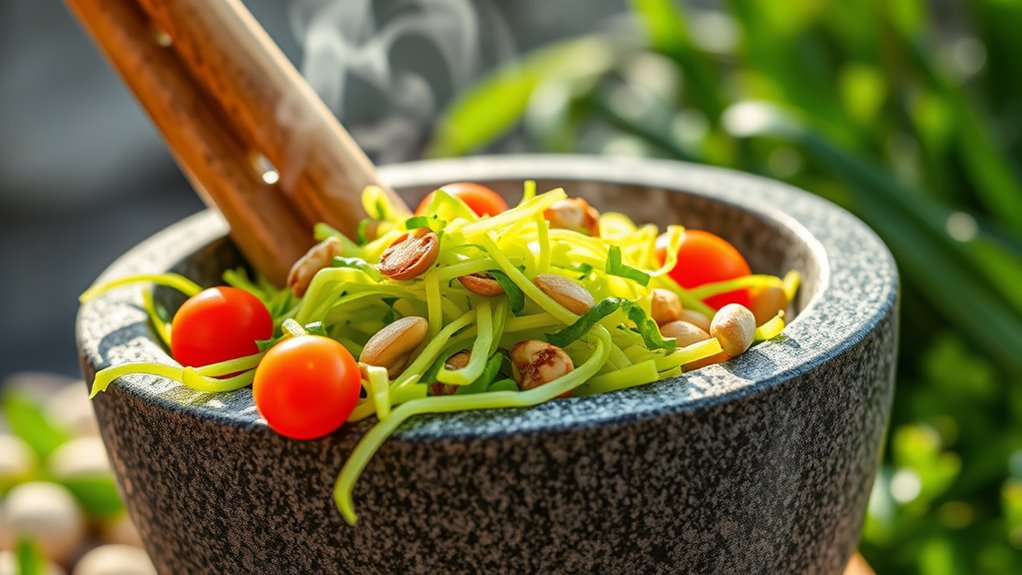
To achieve a harmonious balance of flavors in your Som Tam, you need to skillfully adjust ingredients as you go, using your mortar to blend and refine. Start by adding the spicy chili, then gently pound it to release heat without overpowering. Follow with the sour lime juice and fish sauce, mixing thoroughly to distribute their tang and saltiness evenly. Taste frequently, using the mortar to press and blend ingredients to meld flavors seamlessly. Incorporating proper techniques can also help achieve a more consistent and balanced flavor every time. If the dish is too sour, add a touch of sweetness like palm sugar; if it’s too salty, balance with more lime or chili. Use the mortar to smooth out any harsh edges, ensuring each bite delivers a well-rounded, vibrant flavor profile. Mastering this technique allows you to fine-tune your Som Tam precisely.
Common Mistakes to Avoid When Using the Mortar
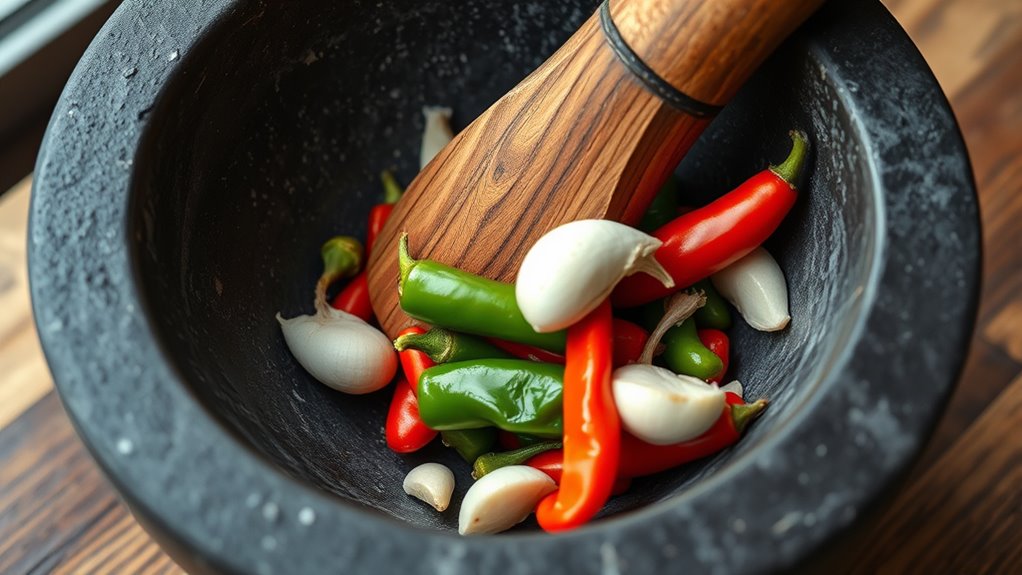
One common mistake to avoid when using the mortar is applying too much force, which can crush ingredients and release bitter flavors. Instead, use a gentle, rhythmic pounding to break down ingredients gradually. Excessive pressure can turn delicate vegetables into mush and overpower the balance of flavors. Another mistake is overpounding ingredients without pausing to taste, which can lead to a dish that’s too salty, sour, or spicy. Be mindful of the texture you aim for—crisp and fresh rather than overly mashed. Also, avoid adding ingredients all at once; layer them gradually to control texture and flavor. Moreover, don’t rush the process. Patience ensures ingredients are properly pounded, resulting in a well-balanced, authentic Som Tam. Incorporating sound vibrations can also help achieve a harmonious texture and flavor distribution during the pounding process. Remember that familiarity with traditional techniques enhances the authentic taste and experience of your dish. Additionally, understanding the Glycolic Acid benefits for skin can inspire patience and careful handling in your culinary techniques, much like gentle exfoliation leads to healthier skin.
Tips for Enhancing Your Som Tam With Skilled Pounding
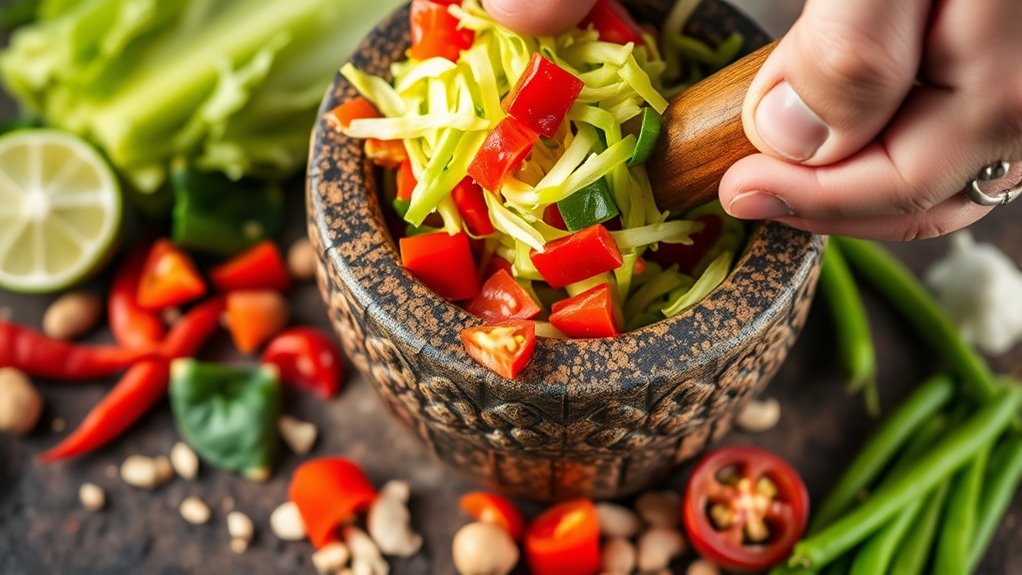
Enhancing your Som Tam with skilled pounding requires more than just brute force; it involves developing a rhythm and technique that bring out the dish’s vibrant flavors. To improve, focus on these key tips:
- Maintain a steady tempo to create a consistent mash, blending ingredients evenly.
- Use the pestle’s weight to control pressure, ensuring gentle yet effective pounding.
- Rotate ingredients in the mortar to distribute flavors and prevent sticking.
- Pay attention to sound; a rhythmic tapping indicates proper technique and helps develop a groove.
- Developing auditory feedback can help you refine your pounding rhythm and technique over time.
- Incorporating the right electric tools or techniques can streamline the pounding process and improve consistency.
- Practicing mindfulness during the pounding can help you stay focused and improve your overall technique, leading to a more relaxed and attentive approach.
- Recognizing airflow around the mortar can also influence the ease of pounding and help maintain a steady rhythm.
- Proper technique in pounding can also enhance the extraction of flavors and textures from the ingredients.
Practicing these steps sharpens your skills, resulting in a well-balanced, flavorful Som Tam that highlights the freshness of the ingredients and the mastery of your pounding.
Frequently Asked Questions
What Types of Mortar and Pestle Are Best for Som Tam?
When making som tam, you want a mortar and pestle that’s sturdy and easy to use. A traditional stone mortar works best because it’s heavy, durable, and helps you grind ingredients evenly. Avoid glass or plastic ones—they can break or don’t provide the right texture. With a good stone mortar and pestle, you can crush garlic, chili, and sugar effortlessly, ensuring your som tam has that perfect, authentic flavor.
How Does the Mortar Shape Influence Flavor Extraction?
You’ll notice that the shape of the mortar considerably impacts flavor extraction. A deeper, rounder mortar allows you to grind ingredients thoroughly, releasing more essential oils and flavors. Meanwhile, a wider, shallow mortar offers better control for gentle mixing and cutting. The shape influences how ingredients collide and release their aromas, so choosing the right one helps you maximize flavor and achieve the perfect balance in your dish.
Can Different Pounding Techniques Alter the Dish’S Authenticity?
A stitch in time saves nine, and in cooking, technique matters. Yes, different pounding techniques can alter the dish’s authenticity. Using a gentle, rhythmic motion maintains traditional flavors, while aggressive pounding might change the texture and intensity. How you pound influences how ingredients meld, impacting the final taste. So, sticking to authentic methods guarantees you capture the true essence of Thai Som Tam, respecting its cultural roots.
What Are Signs of Over-Pounding or Under-Pounding?
When you’re pounding ingredients, signs of over-pounding include a mushy texture and broken, overly fine ingredients, which can ruin the dish’s balance. Under-pounding leaves ingredients too coarse, resulting in uneven flavors and texture. You’ll notice a lack of proper melding, and the flavors won’t come together well. To get it just right, aim for a slightly coarse, fragrant mixture that’s well-blended without becoming paste-like.
How to Clean and Maintain the Mortar for Optimal Use?
To keep your mortar in top shape, you should clean it after each use with warm, soapy water, scrubbing off any residue. Avoid using harsh abrasives that could scratch the surface. Regularly check for cracks or chips, and dry it thoroughly to prevent mold. Occasionally, you can season it with a light coating of oil to maintain its non-stick surface and prevent cracking, ensuring ideal performance every time.
Conclusion
Mastering the mortar and pestle transforms your som tam from good to authentic. When you pay attention to technique, texture, and flavor balance, you’ll create a dish that truly impresses. So, are you ready to embrace the pounding and unleash the full potential of your ingredients? With a little practice, you’ll bring out the vibrant, bold flavors that make Thai som tam unforgettable. Now, aren’t you excited to start pounding your way to perfect som tam?
